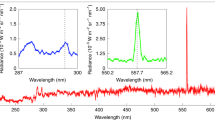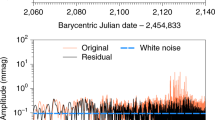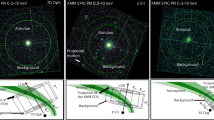Abstract
THE chromospheric Mg II h and k lines seem to have doubly reversed emission core in the spectra of the Sun and of solar and late type stars. In the solar spectrum the general appearance of Mg II h and k is very similar to the H and K of Ca II, but with larger intensity fluctuations. Current ideas suggest that the h and k lines are strongly sensitive to chromospheric parameters. In quiet areas of the Sun the Mg II emission shows asymmetric doubly reversed profile with a brighter blue peak, while in plages the emission is much stronger and nearly symmetrical1. The Mg II doublet seems to be a very useful way of investigating the presence of active regions on stars. We report here the results of our observations of the intensity of the Mg II h and k lines of the star HD206860 collected with the IUE at the Villafranca Satellite Tracking Station of the European Space Agency (ESA). The aim of the observations was to search for short-term variability of the chromospheric emission connected with the rotation period of the star.
This is a preview of subscription content, access via your institution
Access options
Subscribe to this journal
Receive 51 print issues and online access
$199.00 per year
only $3.90 per issue
Buy this article
- Purchase on Springer Link
- Instant access to full article PDF
Prices may be subject to local taxes which are calculated during checkout
Similar content being viewed by others
References
Lemaire, P. & Skumanich, A. Astr. Astrophys. 22, 61–68 (1973).
Wilson, O. C. IAU Symp. No. 71, 447–452 (1976).
Blanco, C. & Catalano, S. Publ. Astr. Soc. Pacific 82, 1293–1304 (1970).
Blanco, C., Catalano, S. & Godoli, G. Mem. Soc. Astr. Ital. 43, 663–667 (1972).
Blanco, C., Catalano, S. & Marilli, E. IAU. Circ. No. 1387 (1978).
Blanco, C., Catalano, S. & Marilli, E. Astr. Astrophys. 36, 297–306 (1979).
Kohl, J. L. & Parkinson, W. H. Astrophys. J. 205, 599–611 (1976).
Hall, D. S. IAU. Coll. No. 29, 287–318 (1976).
Chugainov, P. F. Izv. Krgm. astrofiz. Obs. 55, 94–99 (1976).
Shajn, J. & Albitzky, V. Mon. Not. R. astr. Soc. 92, 771–779 (1932).
Wilson, R. E. & Joy, A. H. Astrophys. J. 111, 221–261 (1950).
Author information
Authors and Affiliations
Rights and permissions
About this article
Cite this article
BLANCO, C., CATALANO, S. & MARILLI, E. IUE observations of an active region of HD206860. Nature 280, 661–662 (1979). https://doi.org/10.1038/280661a0
Received:
Accepted:
Issue Date:
DOI: https://doi.org/10.1038/280661a0
Comments
By submitting a comment you agree to abide by our Terms and Community Guidelines. If you find something abusive or that does not comply with our terms or guidelines please flag it as inappropriate.



